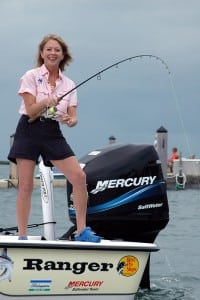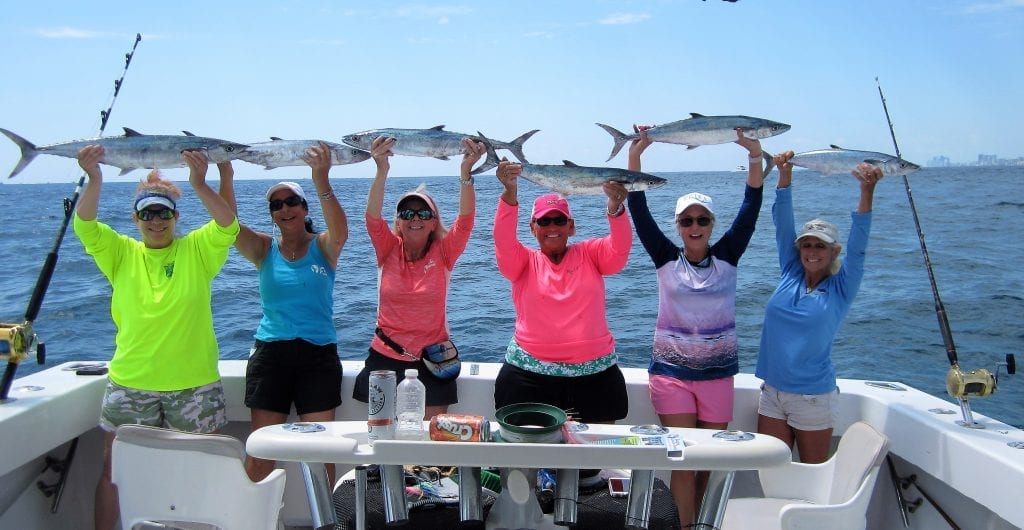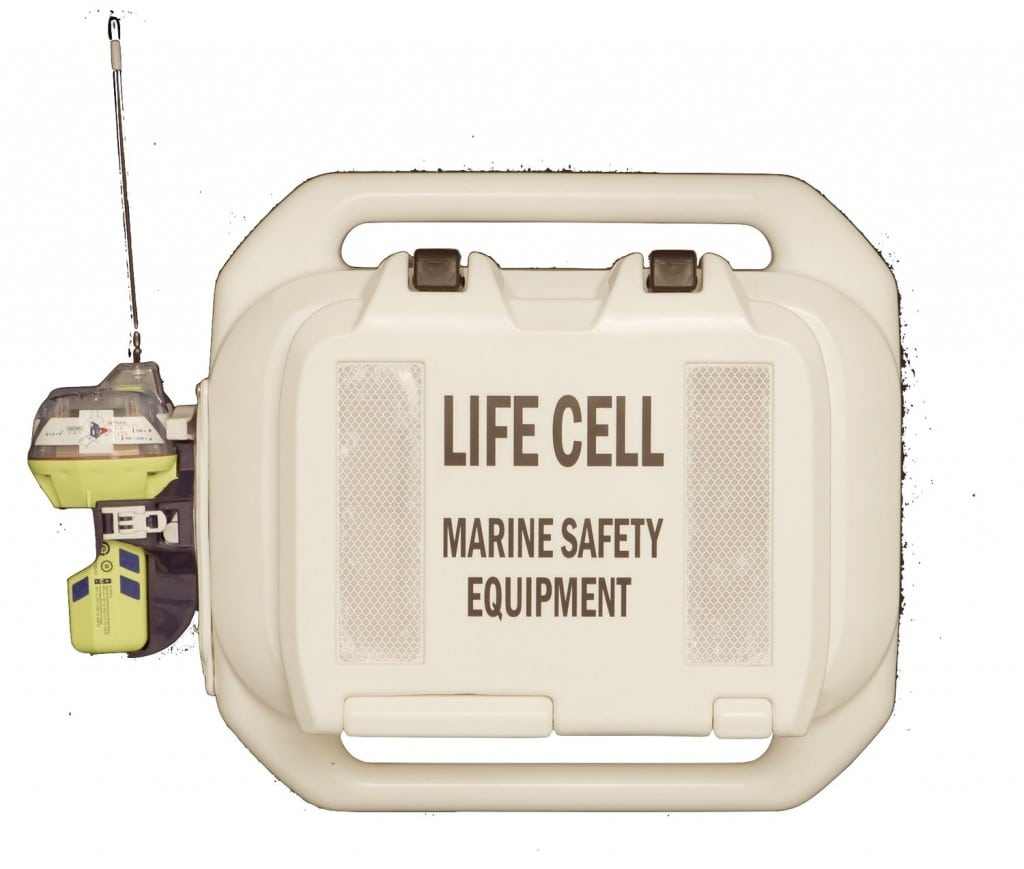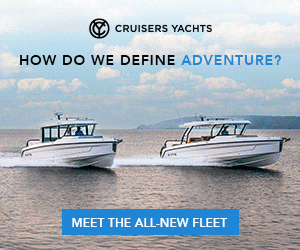Betty Bauman Founder and CEO of “Ladies Let’s Go Fishing!”
Passion, experience and a true understanding of the task at hand spurred the creation of “Ladies Let’s Go Fishing!” the brainchild of Betty Bauman.
SB: Tell us about yourself.
BB: I’m a marketing and PR professional, my background includes handling marketing positions in some of the largest boat companies in the industry (Wellcraft, Donzi, AquaSport), and I started on my own about 20 years ago. I was born and raised in western Pennsylvania. I fished as a child. My first marketing positions were in the cosmetics and cookware industry, and I didn’t get back into fishing really until my job at Wellcraft, where they brought me along as the “token” female. That’s how I fell in love with fishing. It started off with dolphin fishing, mahi-mahi, and I fished with some guys from the Pittsburg Steelers in the Arthur Smith tournament [in Palm Beach, Florida], and it was so much fun. I got my own boat and started fishing on my own. I had a Wellcraft V20 Steplift and I was fishing from trial and error because I really didn’t know that there were special techniques, special knots or anything like that.
SB: How did you really get into fishing and the program?
BB: I had pretty much reached the top level I could with the corporation and felt that I wanted to start my own company. So I did, they [the boat companies] became my clients and I was doing some program magazines for some of the big fishing tournaments in Fort Lauderdale. So because of that I got to learn more and more about fishing, and I married my husband who was a tournament winner. He would yell at me, you know in the heat of the moment he would bark out orders, things I needed to do, and to me that was Greek—I didn’t know what he was talking about, what to do with it, and why I had to do it. And by the time you ask those questions, when you’re in a fishing situation it’s too late.
What really spurred [“Ladies Let’s Go Fishing!”] was that as part of my business I went to the ICAST [International Convention of Allied Sportfishing Trades] show every year. I was at an industry breakfast and the president of the ASA [American Sportfishing Association], Mike Hayden, mentioned that women were a huge part of the potential marketplace that was not properly developed—a light bulb came on. I thought I know why: this sport is intimidating, it’s male-dominated and women don’t understand the terminology. There are a lot of women like me who get frowned upon in situations and are expected to know what to do and they don’t. So my theory was I do marketing, I do events, if we had events where women could learn the theory, have a chance to practice hands-on, and have a chance to go fishing, plus a chance to network, because women like the social aspect to fishing, we could develop more female anglers. I had the business, I had the infrastructure, I was all set up to do it. I approached the Florida Fish and Wildlife Conservation Commission with the concept. They embraced it. I knew it was going to be an expensive proposition, we set up a partnership and then they went to the industry and a lot of the large corporation also set up partnerships. That was 1997.
I started with my first event, which was at Marina Bay [Fort Lauderdale, Florida]. I put together all the structures, I knew I was going to need a lot of volunteers and guides to come out of the water to work with these ladies one on one. The response was overwhelming. The first class was sold out with 85 people—as much as the room could fit. This is an immersion program, we totally immerse the ladies and the strategy and the mechanics of fishing and with hands on.

SB: How has the program changed today?
BB: The program then was a success from the get-go. We’ve made some tweaking but when something is a success you stay with that. So for years we kept the same program but we keep improving the logistics, we expanded the options and fundraisers because we know that we need to raise enough capital to keep the program viable.
SB: What does the program entail?
BB: Our main events start out with a Friday evening social so we can recognize the sponsors, and the ladies get a chance to meet the others. Saturday mornings are the sit-down classes, which are very heavily laden with conservation because the best time to learn conservation is when an angler is new and impressionable. And then we serve lunch.
After lunch we have hands-on fishing techniques, for instance, I show stand up fighting techniques. We have tables for knot tying, lure usage, lure rigging, other fishing skills, sometimes we have how to handle the dock lines; they’re all a little bit different. And then we have spin-casting, net-casting, fly-casting, boat-handling trailer, backing, and landing, we have them gaff grapefruits. On Sunday we have the optional charter fishing, we give them choices, sometimes it’s the choice of a drift boat, a sport fishing boat or an inshore boat depending on the area that they’re in—different parts of the states have a different kind of fishing.
 SB: What do you love most about what you do?
SB: What do you love most about what you do?
BB: The most wonderful part of what I do is enabling and empowering women to enter fishing, to give them the excitement, the knowledge, the skills, and give them a sport that they can enjoy with their families and their friends.
SB: What can we expect from you and your organization in the future?
BB: Since then we’ve added some international trips because once they’re out there and fishing they still want to go with a group and find fishing in other parts of the world. We’ve been primarily Florida but we’ve had some wonderful fly fishing seminars in Colorado, we’ve had some private companies that have hired us to do fishing programs with their female clients.
We have recently added the option to invite male guests or teens, to include the whole family—the focus is still on women but some women want to learn with their significant others, so one can remember what the other one forgets. We’re starting a nonprofit foundation. It’s the “Ladies Let’s Go Fishing!” Foundation, we wanted to take it nonprofit, even though we’ve technically been nonprofit for years, that enables our donors to donate to a charity, the mission is to provide opportunities and education for women and families to learn fishing and conservation skills.
SB: Have you received any recognition for your work?
BB: I belong to the Florida Outdoors Writers Association, I was recently honored by the Bass Pro Shop Pass it On Award, and I’ve been honored by the American Sportfishing Association as “woman of the year.”
SB: What do you like to fish most?
BB: My favorite is kite fishing for sailfish.
SB: When you’re not fishing what are your other hobbies?
BB: Working! I did horseback riding until I got thrown from my horse and broke my ankle a couple of years ago. I like camping, boating, travel.
SB: Any most memorable moments with “Ladies Let’s Go Fishing!”?
BB: It’s exciting to see women from their teens to their 90s attend, all different ages and incomes, but in the room, they’re all equals. We’ve had three generations attend a seminar, grandmother, daughter, and granddaughter.
I get emails from ladies that didn’t know how to fish and pictures of them catching fish in The Bahamas—they do go on and [continue to] participate in the sport. Our sponsors and donors are very important because without them we couldn’t do it. Last year we lost the support of the FWC, which was a potentially huge blow to the program, however, Guy Harvey Ocean Foundation came in, Fish for Florida came in, NMMA and the RBFF [Recreational Boating & Fishing Foundation] helped us.
SB: How many women have gone through your program?
BB: Eight thousand! That’s a lot considering that it’s hands-on.
SB: What sets you apart from other fishing programs?
BB: It encompasses an entire weekend and it’s all the elements, the social, the hands-on and the classes, and the fishing experience. It’s quite laborious; I don’t know who else is willing to give up their time to do a program like this. I donate a lot of time to it.
SB: If you’d like to add anything, please feel free.
BB: I’d like to mention the conservation and how important the industry organizational support is to the program. We’re very grateful for it and some people have been with us for many years, and they provide products and that allows us to show many more kinds of fishing equipment that we could afford to buy.
By Nathalie Gouillou, Southern Exposure















